35mm Static Camera
Shots
By simply putting a
camera on a tripod, pointing at the sky, and opening the shutter
even with a wide angle or standard lens it is possible to get
images showing the constellations. If the mount is driven far
more detail is picked up and the stars instead of trailing appear
as clear points, often exhibiting colour.
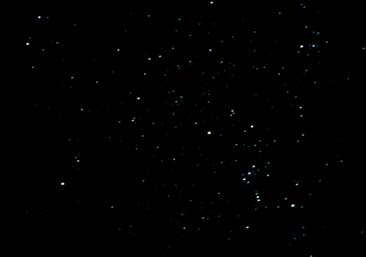
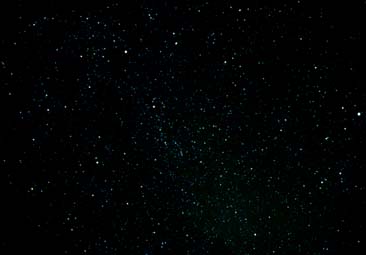 Two 35mm shots showing
Orion and Gemini on the left - not driven, and Cygnus & Lyra
on the right with a driven mount. Note the difference in the fainter
stars visible, and the lack of trailing in the Cygnus picture.
The images are a little small for this example, but I hope you
get the picture.
Two 35mm shots showing
Orion and Gemini on the left - not driven, and Cygnus & Lyra
on the right with a driven mount. Note the difference in the fainter
stars visible, and the lack of trailing in the Cygnus picture.
The images are a little small for this example, but I hope you
get the picture.
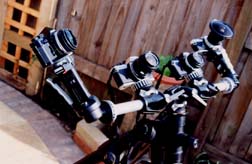 ................
................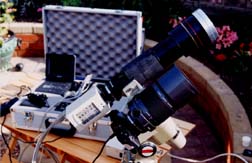 A static camera bank
as used for meteor work, and a driven 600mm telephoto lens for
use at a solar eclipse.
A static camera bank
as used for meteor work, and a driven 600mm telephoto lens for
use at a solar eclipse.
 ...
...  ...
... Effect of focal length
on field of view 8mm - 16mm - 50mm
The camera on tripod
is also useful for taking images of passing moments such as the
position of the moon, and the planets with respect to the background
sky.
Effect of focal length
on field of view 8mm - 16mm - 50mm
The camera on tripod
is also useful for taking images of passing moments such as the
position of the moon, and the planets with respect to the background
sky.
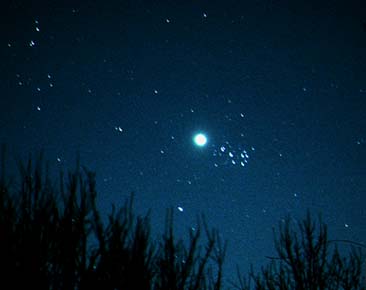 ...
...
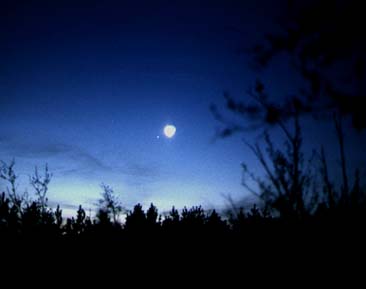 The Moon & The
Seven Sisters - The Moon & Venus. A little foreground foliage
often helps the shot.
The September 2002
visit to the Thetford Star Party allowed a night for some piggyback
imaging. I used Fuji Sensia 440 slide film and exposed for approximately
30 minutes with a range of wide-angle lenses. The sky wasn't really
dark enough, and the images were a little over exposed. I did
however mange to scan the slides, and tweak some info out of them.
Here are some examples.
The Moon & The
Seven Sisters - The Moon & Venus. A little foreground foliage
often helps the shot.
The September 2002
visit to the Thetford Star Party allowed a night for some piggyback
imaging. I used Fuji Sensia 440 slide film and exposed for approximately
30 minutes with a range of wide-angle lenses. The sky wasn't really
dark enough, and the images were a little over exposed. I did
however mange to scan the slides, and tweak some info out of them.
Here are some examples.
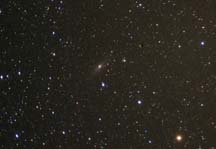 .......
.......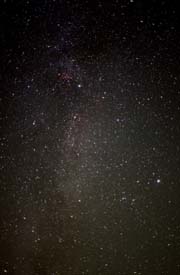 .......
.......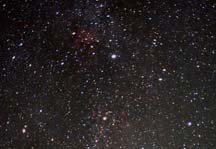 The Andromeda nebula
M31, The region of Cygnus, see how many stars are visible compared
to the image at the top of the page. IN addition I have taken
a detailed region of this slide to highlight the North America
Nebula. Now all I have to do is get to a really dark sky, and
see what I really can accomplish.
Prime
Focus - Afocal shots - Eyepiece
Projection shots -
35mm
Imaging
For more details on
Astrophotography I recommend:
Michael Covingtons
Book - Astrophotography for the Amateur
.. Astronomy Main.. Home
The Andromeda nebula
M31, The region of Cygnus, see how many stars are visible compared
to the image at the top of the page. IN addition I have taken
a detailed region of this slide to highlight the North America
Nebula. Now all I have to do is get to a really dark sky, and
see what I really can accomplish.
Prime
Focus - Afocal shots - Eyepiece
Projection shots -
35mm
Imaging
For more details on
Astrophotography I recommend:
Michael Covingtons
Book - Astrophotography for the Amateur
.. Astronomy Main.. Home